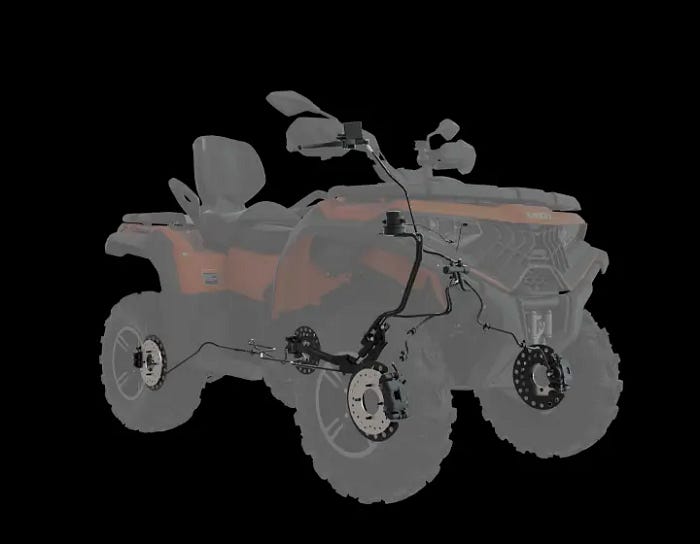The braking system of the LONCIN XWolf 700L is a crucial component that ensures safe vehicle operation and efficient braking performance.

Basic Working Principle of the Braking System
The LONCIN XWolf 700L braking system likely employs a hydraulic mechanical braking system. Its working principle is based on Pascal’s Law, which converts the driver’s applied braking force into hydraulic pressure to actuate the wheel brakes and decelerate or stop the vehicle.
Braking Initiation: When the driver presses the brake pedal, the pedal lever amplifies the force, pushing the master cylinder (primary pump) piston.
Hydraulic Pressure Build-up: The piston compresses the brake fluid, converting mechanical force into hydraulic pressure. This pressure is transmitted through the brake lines to the wheel cylinders (secondary pumps). Modern vehicles typically use a dual-circuit design to ensure partial braking capability even if one circuit fails.
Braking Force Amplification and Execution: The hydraulic pressure pushes the wheel cylinder pistons, causing the brake shoes to expand and friction the brake drums (in drum brakes) or pushing the caliper pistons to clamp the brake discs (in disc brakes), thereby generating braking force.
Braking Force Release: When the pedal is released, the master cylinder piston returns to its original position, and the brake fluid flows back into the master cylinder. The brake shoes or pads retract due to springs or seals, releasing the friction.
Technical Features of the Braking System
Given the XWolf 700L’s high-performance off-road positioning, its braking system likely features the following advanced technologies:
High-Performance Brakes: The vehicle may be equipped with high-performance disc brakes, which offer superior heat dissipation and stable braking force, making them suitable for complex terrain and high-load conditions.
Electronic Hydraulic Braking (EHB): This system uses an electric motor to drive a hydraulic pump to generate high-pressure brake fluid and controls the assist level via solenoid valves, eliminating the need for a vacuum booster. EHB systems respond quickly, enhancing emergency braking safety and seamlessly integrating with regenerative braking systems.
Anti-lock Braking System (ABS): ABS monitors wheel rotation speed in real time. When it detects a tendency for wheel lock-up, it rapidly switches the brake chamber pressure to maintain the optimal slip ratio (10%–30%) of the tires, preventing tire skidding and improving stability and safety during braking.
Functional Analysis of the Braking System
The braking system of the XWolf 700L not only meets the demands of everyday driving but also performs exceptionally well under complex terrain and high-load conditions:
Efficient Energy Recovery: If equipped with a regenerative braking system, the vehicle can convert some kinetic energy into electrical energy during braking store and it in the battery, thereby improving energy efficiency.
Adaptability to Various Conditions: The braking system can automatically adjust braking force according to different road conditions and load conditions, ensuring effective braking on muddy, rugged, or slippery surfaces.
Emergency Braking Capability: In emergency situations, the electronic hydraulic assist system can respond quickly, providing strong braking force to shorten the braking distance.
The braking system of the LONCIN XWolf 700L combines advanced hydraulic mechanical braking technology with electronic assist systems to ensure safe braking capabilities under various complex conditions while also balancing energy efficiency and driving comfort.